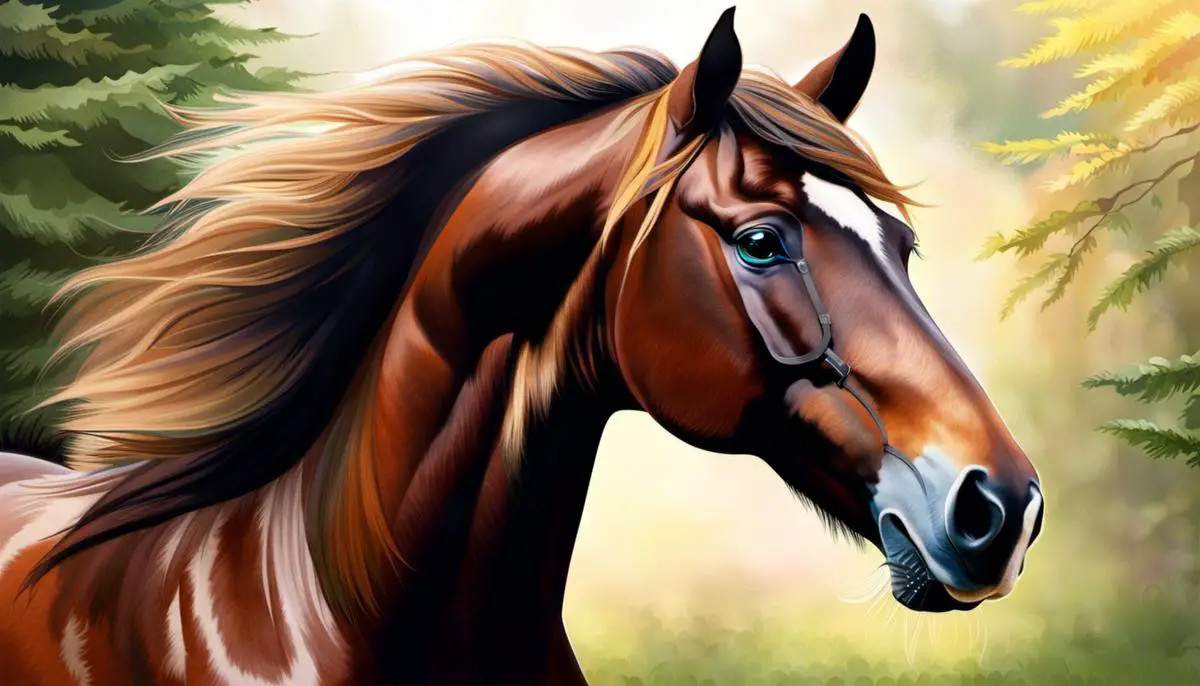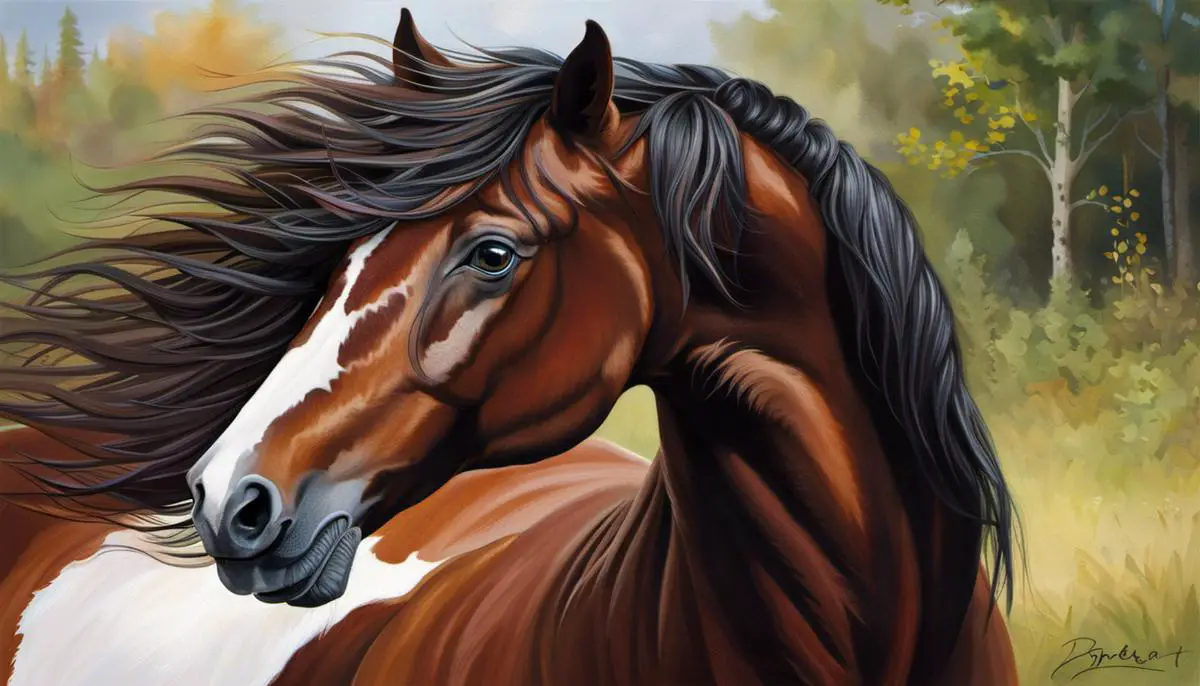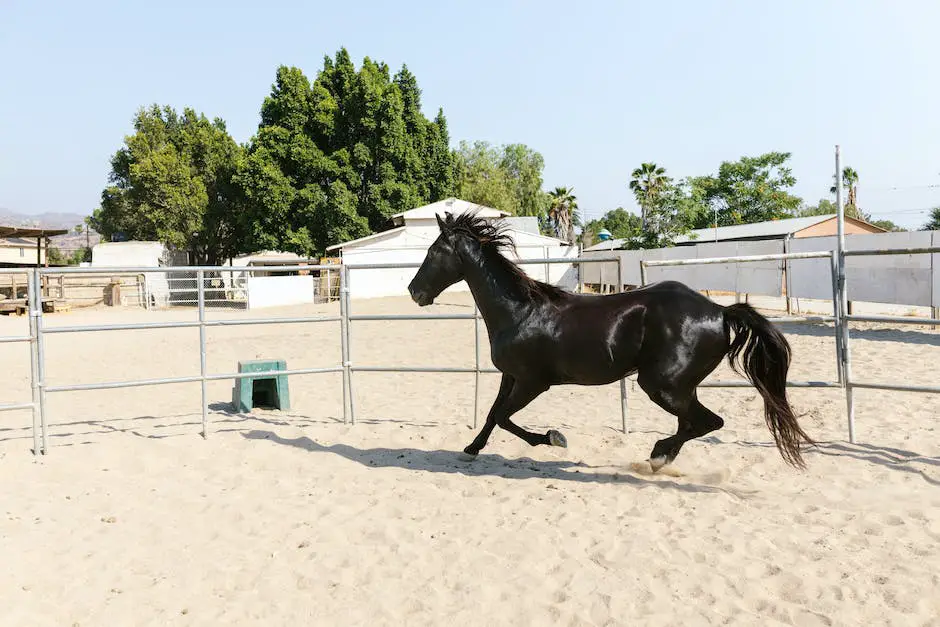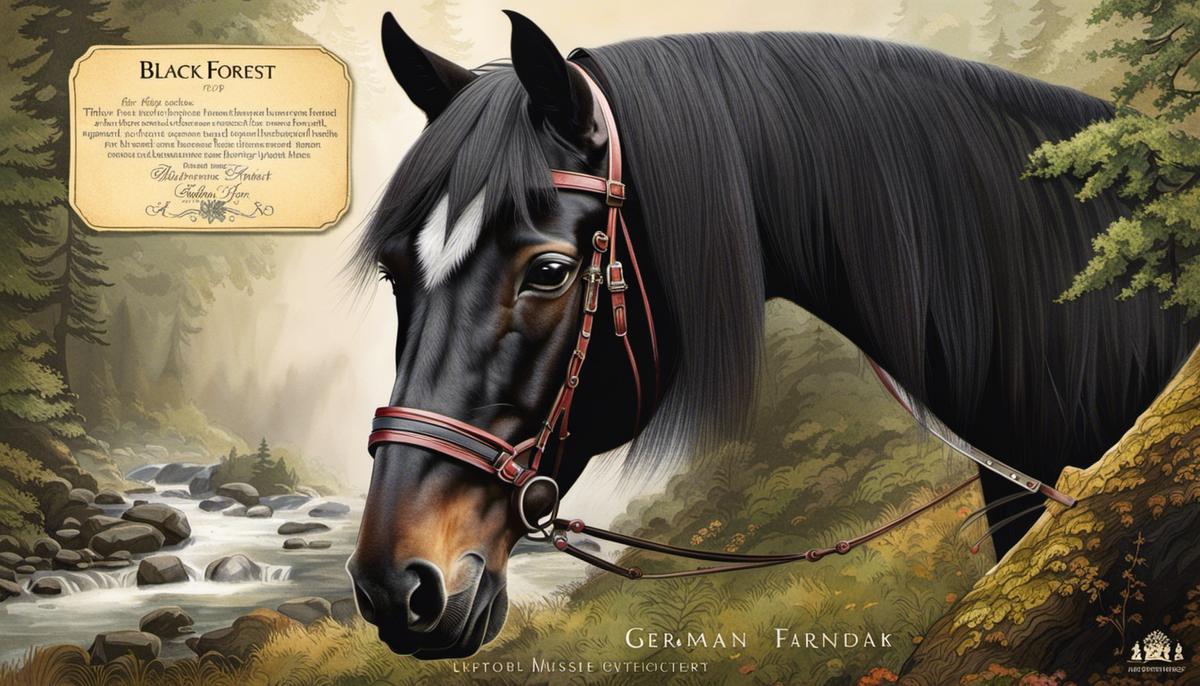The Black Forest Horse, renowned for its majestic beauty, humble demeanor, and rich history, is truly a breed that captivates horse-enthusiasts around the world. Steeped in the culture and traditions of Germany’s Black Forest region from where it originates, this breed has endured centuries of change and development. With its robust physical characteristics, versatile temperament, and indispensable role in various tasks, the Black Forest Horse continues to awe and inspire. Maintaining this heritage breed requires a thorough understanding of its dietary, health, and exercise needs, all of which contribute to its well-being and longevity. In the modern era, despite facing challenges, the breed remains highly valued in equestrian sports, companion roles, and by breed preservationists committed to its survival.
Table of Contents (Horspedia)
History of the Black Forest Horse
Origins in Germany’s Black Forest
The Black Forest Horse, also known as the Schwarzwälder Kaltblut, has a rich history beginning in the heart of Germany. This horse breed hails from the Black Forest region in Baden-Württemberg, known for its dense woodlands and mountainous terrain. These horses were first mentioned in historical documents from the late 15th Century and have been developed from robust, work-type stock used for agriculture and pulling heavy loads in difficult terrains.
Historical Uses
Traditionally, Black Forest horses were used as work animals in the timber and agricultural industries. They were highly sought after due to their strength, durability, and calm temperaments, making them ideal for heavy work in the challenging environment of the Black Forest region. These horses were also utilized for transportation of goods across challenging terrains, reflecting their exceptional adaptability and resilience.
Changes and Evolution Over Time
As horses became less necessary for labor and more valued for leisure activities and sports in the 20th century, the Black Forest horse experienced a period of decline. The breed’s functionality in modern society decreased, and their numbers dwindled to near extinction. However, earnest efforts were made to maintain the breed out of respect for their historical contribution and heritage.
From the 1960s onwards, controlled breeding strategies were implemented to preserve the breed, leading to the creation of the more modern variety of Black Forest Horse seen today. This modern breed is lighter and more versatile, yet retains the power and temperament of its forebears that make it perfect for recreational driving and riding activities.
Survival and Preservation
Despite periods of near extinction, the Black Forest Horse breed has demonstrated remarkable resilience. In the late 1980s, the breed experienced a revival due to increased interest in preserving rare and historic breeds. Breeders began focusing on improving the breed’s versatility, thereby ensuring its adaptation and survival in the modern world. Today, they are a popular choice for leisure riding, demonstration driving, and farm work.
Present Condition of the Black Forest Horse Breed
The Black Forest Horse, celebrated for its remarkable stamina, appreciable speed, and amicable personality, currently enjoys a modest but gradually increasing population due to thoughtful and regulated breeding. The breed’s survival and resurgence illuminate its historical importance and persistent ability to adapt. This charismatic German draft horse, distinguished by its dark chestnut body and golden, flowing mane, not only captivates with its beauty but also embodies a rich piece of Germany’s cultural heritage.

Physical Characteristics and Temperament
Unique Traits and Features of Black Forest Horses
Black Forest horses, named after their birth region in Germany, are compact yet powerfully built draft animals. These horses tend to stand between 14.1 and 15.1 hands tall, although a few may grow up to 16 hands. Despite their compact stature, they are muscular and robust, possessing long, sturdy necks, a broad, deep chest, and solid, powerfully built legs. Their distinctively long, curly manes and tails, typically a golden flaxen color, set them apart.
Their attractive dark chestnut coat, often called “fox” color, is the breed’s signature, but shades of brown or bay also surface. Features like expressive eyes, an adequately large and well-structured head, and small but vigilant ears define the face of these horses.
The breed’s lush and fluffy mane gives it an enchanting, fairytale-like appeal. Equally important is their dense, straight, and weather-resistant coat that proves essential during Germany’s severe winter weather.
Furthermore, Black Forest horses’ comfortable gaits, which include a lively, high-stepping trot and a fluid, rhythmic canter, make them an absolute delight to ride.
Temperament and Behavioral Traits of Black Forest Horses
The Black Forest horse is known for its calm, friendly and dependable temperament, making them an excellent choice for both work and companionship. They are fast learners, which alongside their remarkable strength and endurance, makes them perfect as working horses.
These horses were traditionally used as draught animals in forestry work, agriculture, and pulling carts but today they are also appreciated as leisure and sports horses. Despite their strength, they are exceptionally gentle and eager to please, establishing an easy rapport with both adults and children.
They demonstrate a high level of adaptability, can handle stress well, and are generally easy to handle, which makes them ideal for beginner riders as well. Their natural curiosity and intelligence make them engaging companions. They possess a robust constitution and are known for their longevity, often living up to the age of 20 years or more with proper care.
Understanding the Versatility of the Black Forest Horse
Black Forest horses distinguish themselves through their potent physique and serene temperament. Throughout history, they have been critical components of local transportation and farming labor in their native regions. Their impressive build and high stamina make these horses capable of hauling hefty weights. In contemporary times, these horses contribute not only to farming and forestry labors but also to recreational activities, horse riding schools, and even therapeutic programs. This is largely owing to their peaceful nature and forbearing patience.
Wrapping up, the blend of physical skills and temperamental attributes possessed by the Black Forest Horse qualifies it as a perfect breed for a range of jobs and companionships. Its adaptability, stamina, and striking appearance persistently ignite the interests of horse aficionados globally.

Care and Upkeep
Mindful Feeding: Ensuring the Black Forest Horse’s Health Through Diet
To preserve its robust health, a balanced diet is vital for the Black Forest Horse, just like other horse breeds. These sturdy horses, historically engaged in farming and forestry work in Germany’s Black Forest region, primarily consume forage-based diets such as hay, with added grains, fruits, veggies, and dietary supplements as required according to their activity level.
A large portion of a Black Forest Horse’s diet should consist of high-quality hay or pasture, which is crucial for their digestive wellbeing. If the horse is used for strenuous labor or show purposes, supplemental grains may also be introduced. It is also important to provide the horse with continual access to fresh, clean water and a salt block for balanced electrolyte levels.
Grooming: Ensuring a glossy coat and optimum health
With their lush manes and tails, Black Forest Horses require routine grooming. This includes daily brushing to keep their coats glossy and to remove any dirt, knots, or tangles in their mane and tail. Regular grooming not only keeps the horse looking its best, but is also an excellent opportunity to check for any signs of problems, such as ticks, cuts, or skin conditions. Hoof care is essential – hooves should be picked out daily, and professionally trimmed every six to eight weeks. Additionally, as Black Forest horses sport luxurious feathers on their lower legs, keeping these clean and free of matting is important.
Exercise: Key for fitness and mental stimulation
Exercise is crucial to the overall health of a Black Forest Horse. A sedentary lifestyle can lead to various health issues, including obesity and laminitis. An ideal exercise routine involves daily turnout for free movement and play, along with structured work, whether that involves riding, driving, or another form of training. Regular turnout also benefits the horse’s mental health, providing interest and necessary social interaction with other horses.
Health Care: Regular check-ups and vaccinations
Like any horse, the Black Forest Horse requires regular veterinary care. Ensure the horse receives routine vaccinations against equine diseases and regular dental check-ups. Deworming should be carried out every few months to prevent internal parasites.
Despite their hardy nature, Black Forest Horses are not immune to health issues. Take the time to educate yourself on potential signs of illness or discomfort – changes in appetite, unusual behavior, weight loss, or lameness – and be proactive in seeking veterinary assistance if you suspect something is amiss.
A General Overview: Keeping Your Black Forest Horse Healthy
Owning and caring for a Black Forest Horse can be an enriching experience. By adhering to a well-balanced diet, regular grooming, adequate exercise, and a thorough health care routine, you can ensure your horse attains and maintains peak health and vitality.

The Black Forest Horse in Modern Times
Present-Day Black Forest Horse: A Diversified and Beloved Breed
Commonly referred to as Schwarzwälder Kaltblut in its homeland of Germany, the Black Forest Horse has experienced a notable transition from serving as a traditional farm workhorse to gaining recognition in competitive equestrian sports and leisure riding activities in the present day. Noted for their versatility, physical strength, and gentle nature, this horse breed satisfies various equestrian needs. Whether it’s dressage, driving, leisurely horseback riding, or involvement in therapeutic riding programs, the Black Forest Horse continues to be valued for their robustness and ability to adapt.
Black Forest Horse: Global Reach and Popularity
Originating from the Black Forest region of Southwestern Germany, this compact and robust breed has gained popularity beyond its borders. Breeders and horse enthusiasts in the United States, Canada, United Kingdom, and many European countries have embraced the Black Forest Horse, owing to its multiple abilities and reliability. The breed’s appeal does not just lie in its cold blood characteristics and endurance but also its distinctive chestnut color that makes it stand out in any equine crowd.
Current Breeding Programs for the Black Forest Horse
Breeding programs for the Black Forest Horse are firmly in place, both in its native Germany and abroad. These programs strive for thorough selection to ensure the conservation of the breed’s unique characteristics. While the numbers of Black Forest Horses had declined by the late 20th century, concentrated efforts to preserve and promote the breed have seen their numbers rise. Specific breed standards, detailed genetic testing, and a considered approach to selection are all integral features of prioritized breeding programs.
Preservation Efforts for the Black Forest Horse
The preservation of the Black Forest Horse is a concern for breed enthusiasts and horse preservation societies globally. The German Schwarzwälder Kaltblut Breeders Association has been particularly proactive, implementing stringent breeding regulations to maintain the breed’s unique traits. Likewise, other global organizations, such as the North American Black Forest Horse Association, are working similarly. These collective efforts are crucial to ensure that the breed’s lineage stays pure and that it continues to flourish in the coming years.
Black Forest Horse: A Modern Day Asset
In conclusion, the Black Forest Horse has successfully transitioned from being a draft horse breed to becoming a treasured asset in the equestrian world in modern times. Its strength, temperament, and stunning looks have earned it a notable place in horse societies around the world. Now, through careful breeding and committed preservation efforts, future generations can continue to appreciate the legacy of the Black Forest Horse.

From its historic roots in the Black Forest region to its contemporary relevance across the globe, the Black Forest Horse is a testament to resilience, adaptability, and the power of thoughtful preservation efforts. Enriched by its unique physical characteristics and balanced temperament, it serves as an incredible partner in various modern equestrian disciplines. The importance of proper care, a balanced diet, and appropriate exercise regimes are essential to ensure its health and performance. The enduring appeal and versatility of the Black Forest Horse continue to endear it to horse-enthusiasts everywhere, cementing its place not just in the past, but also in the future of equestrian pursuits. Irrefutably, the breed’s distinguished stature, coupled with its undeniably fascinating history, paint a compelling tale of survival, change, and triumph that resonates through time.
